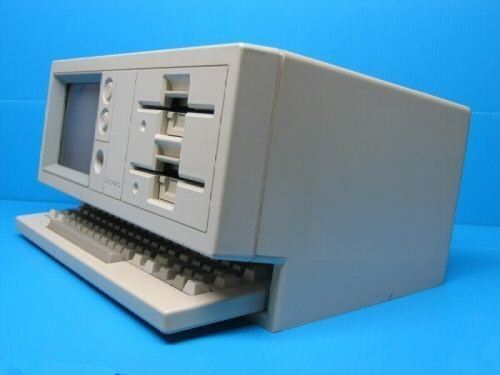Developer Dynalogic Discontinued Approximately 1985 | Manufacturer Dynalogic Introductory price C$4995 | |
 | ||
Release date January 1983; 34 years ago (1983-01) | ||
The Hyperion is an early portable computer that vied with the Compaq Portable to be the first portable IBM PC compatible. It was marketed by Infotech Cie of Ottawa, a subsidiary of Bytec Management Corp., who acquired the designer and manufacturer Dynalogic in January 1983. In 1984 the design was licensed by Commodore International in a move that was forecast as a "radical shift of position" and a signal that Commodore would soon dominate the PC compatible market. Despite computers being "hand-assembled from kits" provided by Bytec and displayed alongside the Commodore 900 at a German trade show as their forthcoming first portable computer, it was never sold by Commodore and some analysts downplayed the pact. The Hyperion was shipped in January 1983 at C$4995, two months ahead of the Compaq Portable.
Contents
Brand Development
The name "Hyperion" was invented by Taylor|Sprules Corporation in Toronto. They also designed the retail packaging in full colour (a first at the time), all marketing materials and the tradeshow exhibit at Comdex in Atlantic City where Hyperion was first introduced in 1982. Steve Jobs was one of the interested visitors at the Dynalogic (Hyperion) exhibit.
Design
The machine was advanced for 1982, featuring 256 kB RAM, dual 360 kB 5.25" floppy disk drives, a graphics card compatible with both CGA and HGC, a video-out jack, a built-in 7-inch amber CRT, 300 bit/s modem, and even an acoustic coupler. It included a version of MS-DOS called H-DOS and bundled word processor, database, and modem software. While the Hyperion weighed just eighteen pounds (8.2 kg), or about 2/3 the weight of the Compaq, it was not as reliable or as IBM compatible and was discontinued within two years.
Interface
H-DOS was remarkable and is of historical significance because it featured a simple menu system. The F1 through F5 keys beneath the 7" screen corresponded to five menu items displayed at the bottom of the screen. This menu was context sensitive and greatly facilitated entering DOS commands. All but the least frequently used commands were available as F-key menu selections, and this greatly reduced the amount of typing required. This user interface was comparable to the many DOS shell programs available at the time, but functioned much more smoothly because of the soft key concept.
The soft keys were also featured in the word processor, database, and modem software that came bundled with the Hyperion, where they were used to select application commands from context sensitive menus.
